While it is easier to walk on and access various sections of a flat rooftop with or without a ladder, setting up ladders on angled roofs can be quite challenging. Most ladders are designed to work on a level surface, making it much harder to create a stable ladder base atop a slanting surface.
To place a ladder on a sloped roof, first assess the roof to find out the most ideal tools for a proper configuration. For a basic setup, use an extension ladder and a ladder hook to secure the ladder to your roof.
For an advanced setup, you require multiple ladders and stabilization accessories including the Pivit ladder tool, ladder levelers and roof boot to aid in holding the ladder or ladders in a fixed position.
Owing to the fact that you will be working on the roof, far away from the ground, you may also need some means to support yourself. The chances of falling are higher than when using the ladder on the ground. The following are the details plus safety measures.
1. Assessing Your Roof
Roofs are made different. This means that how a given type of roof will handle an object placed on it varies a lot. Some roofing materials are easily breakable while others like metal or tiles are strong enough to handle a substantial amount of weight.
Some are slippery while others have coarse surfaces that won’t let objects slide.
Having an understanding of the type of roof will help determine the type of ladder and the additional tools you will need to set up the ladder.
Besides understanding the type of roof you have, it is also important to do a visual inspection of your roof to check for any signs of significant damage. Simply stand on the ground and have a look at your roof. If you cannot see all the sections of your rooftop from the ground outside, you can use a drone. You can also get into your attic to check for any problems.
2. Setting Up the Ladder on Roof +Tools
Once you’ve assessed your roof, the next step is finding the appropriate ladder. There are many types and designs of ladders on the market today.
Although there are several good multi-purpose ladders, the best hook ladders for rooftops come with designs and features that make the whole process of setting them up on the roof easy and efficient.
The ACRO – Chicken Ladder Kit is one of the best recommendations for extremely sloped roofs. This kit consists of two 6′ steel chicken ladders and a ladder hook. It has raised solid steel rungs for quick on and off tasks and also for staging of materials or workers on angled roofs.
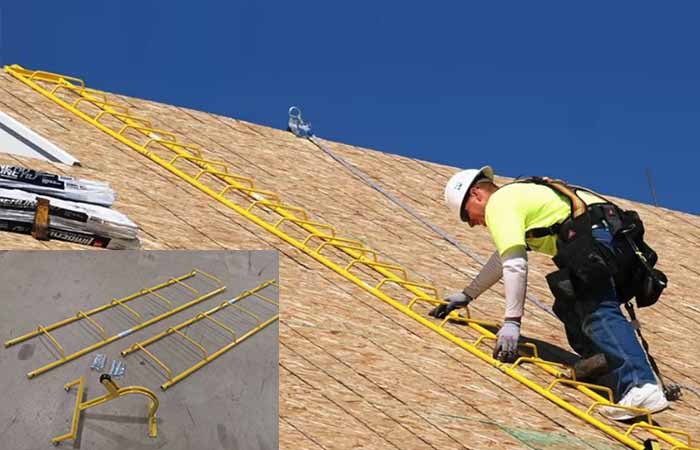
The steel hook comes with a wheel to roll-Up roof without damaging the roofing materials. With additional ladder sections, this kit creates rolling positional climbing and staging aid up to 24′ long.
Extension ladders such as this are also a good alternative if you don’t have the chicken ladder. Most of these ladder types are long, lightweight and sturdy. Some come with helpful features such as grippers at the bottom to prevent slipping.
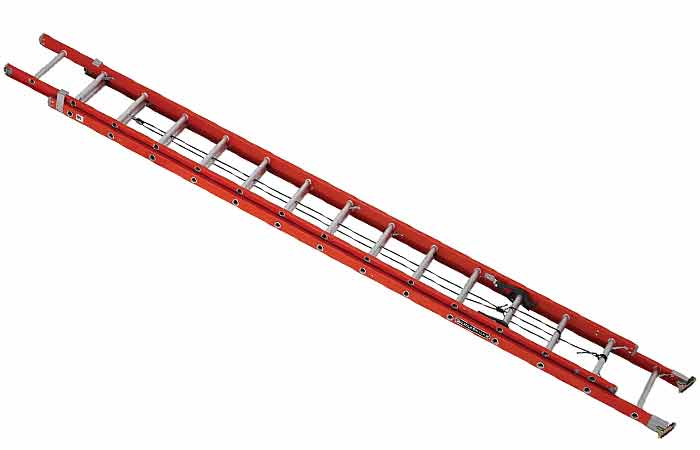
Although it is possible to use the same ladder to get yourself from the ground to the roof and at the same time put it on the roof, having at least one ladder is safer and more convenient.
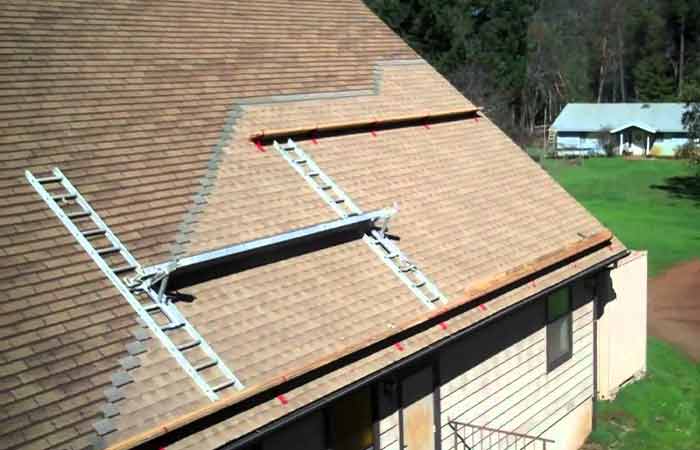
Ladder set up on pitched roof
Once you are ready with the ladders, all you need is to climb to the roof, get your rooftop ladder and set it up. You can have someone to watch you out as well as help with some tasks.
Following are some tools that you may need to make the ladder stay stable and in position.
Roofing Ladder Hook
A ladder roof hook is a supporting tool that allows you to attach your extension ladder over the ridge of the roof. In other words, a hook stabilizes your ladder from the top rather than the bottom. In the case that the stabilizer at the base of the ladder slips, the hook will keep it in place.
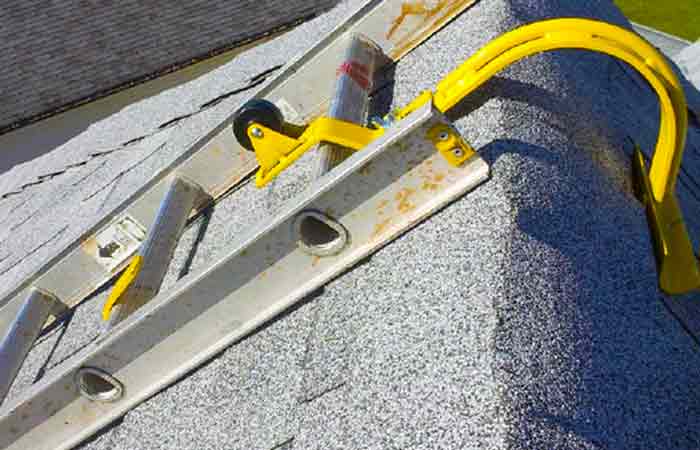
Sometimes referred to as ridge hooks, most roof ladder hooks come in pairs and they hold either side of the ladder to keep it stable. They often have wing nuts to provide a stable and reliable hook of the ladder.
Some hooks also have extensions that can be used for hanging other objects such as buckets
Good roof ladder hooks are not only built with sturdy lightweight materials but also designed with a convenient wheel to allow ladders to roll along the roof without damaging some roofing materials such as shingles. The best are also adjustable and fit both round and-rung styles. Some of the top roof ridge/ladder hooks are for your rooftop tasks include.
Tie Down Engineering Roof Zone 65005 Ladder Hook with Wheel Roof Ridge Extension
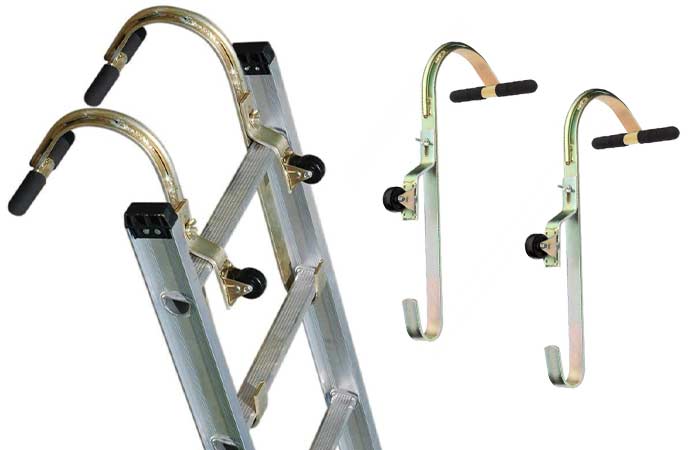
Qualcraft 2481 Ladder Hook with Wheel
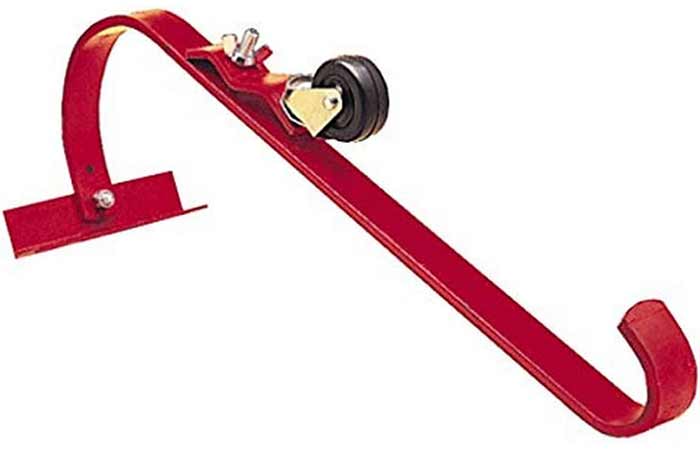
PiVit Ladder Tool for Ladder Base Stability
The PiVit tool is ladder-base leveler mostly used to hold ladders not only on sloping roofs but also uneven ground. It’s a triangular tool which is put on the sloping roof to provide a flat surface for one or both legs of the ladder.
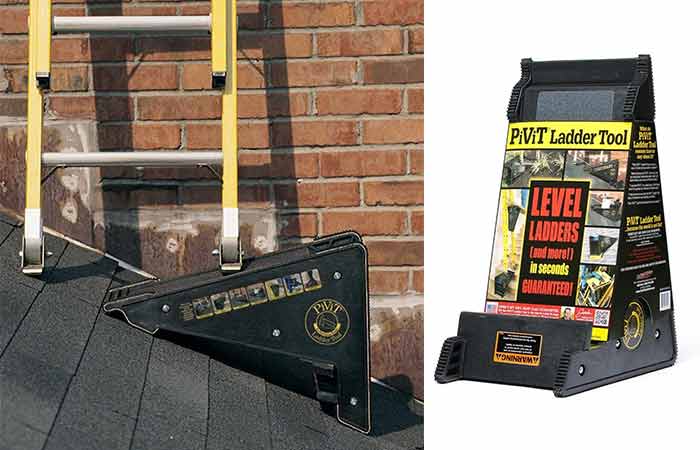
While hooks hold the ladder from the top, this tool holds the ladder from the bottom. You can use it to instantly level any ladder you have, including your step ladder. The PiViT even doubles as a stable platform that will hook onto ladder rungs
It is a multipurpose tool that works indoors and out, besides on top of roofs, you can use it on uneven ground, and stairs.
The hundreds of rubber gripper feet made from rugged conveyor belt material will keep the ladder from slipping. In addition to providing traction, the rubber protects the shingles and other roofing materials.
It less bulky and lightweight. It comes with no bolts or clamps which makes transferring it from ladder to ladder quick and easy.
Since this is not affixed to the roof, you may need a fall protection kit, or you should have a way of locking it into place.
The Goat LLC Steep Assist Roof Ladder
The Goat Steep Assist roof ladder is yet another tool you can use to access a sloping roof. This device is to be used only as first man up, last man down and or one-man inspection tool. It comes with (5) 4′ poles and a soft touch hook pad and wheel.
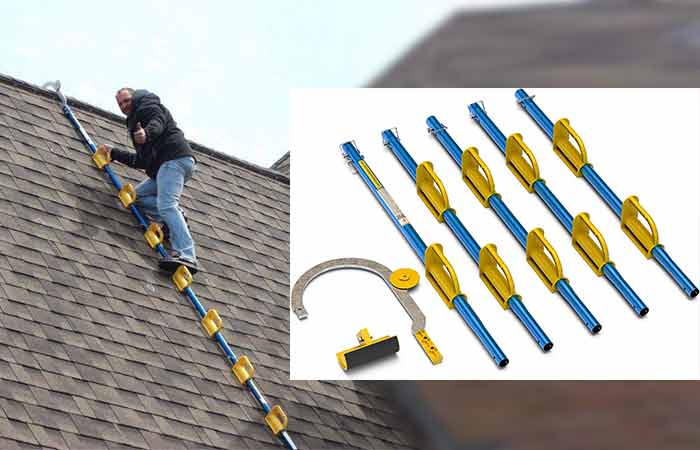
More features include;
- 20LF Total weight 16LBS.
- Product Length: 20 Ft.
- Weight limits do not exceed 350 lbs when using this device.
- Roof pitch limits do not exceed 45 degrees /12/12 pitch.
Ladder Stand-off/Mounts to get on Roof with Gutters
If you have gutters on your house, you can use a ladder stand-off or a gutter mount to safely get your ladders on the roof.
A ladder stand-off or offset or stabilizer is an accessory that you attach to the top of your ladder so that the weight of the ladder is on the roof instead of the gutters. It keeps your ladder away from the gutters while giving you room to safely work without causing any damages
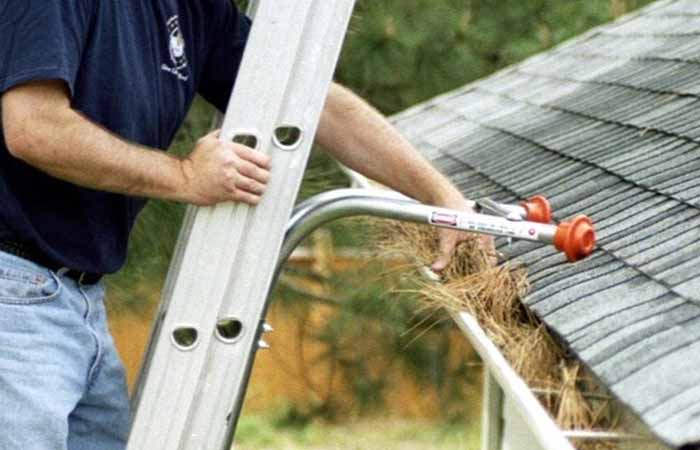
On the other hand, a gutter mount is a tool that fits into your gutter to support a ladder safely in place while preventing gutter damage. It distributes the weight of the leaning ladder onto the back part of the gutter,fascia, not the front
Roof Boot
Another tool that provides assured support for the ladder is the roof boot. This is because the roof boot is drilled or nailed into the roof to give it a steady footing. The fact that it’s made to be part of the roof means that it provides a more stable base than the Pivit ladder tool for example.
To use this tool, locate the place where the ladder will be placed then use a hammer to drive long nails into the roof to support the roof boot. You then place the ladder on it with one or both feet attached. You can use the roof boot to steady a Pivit tool as they both offer great support to the ladder.
Ladder Leveler
A ladder leveler, as the name suggests, helps keep the rungs of your ladder on a horizontal plane. In most cases, the roof will be sloped but at different angles for different roofs. The leveler works in the same way a Pivit tool does as it acts as a base for one leg of the ladder to stand on while the other stands on the roof.
Ladder Leash
The ladder leash helps prevent the ladder from sliding away when you add weight to it. This happens by wrapping one leg of the ladder with the leash and then the other end of the leash to the roof. You can nail the other end of the leash to the roof for the best results.
With these tools in place, you can easily access roofs on upper floors. Most of them can also be used to hold ladders in place on staircases.
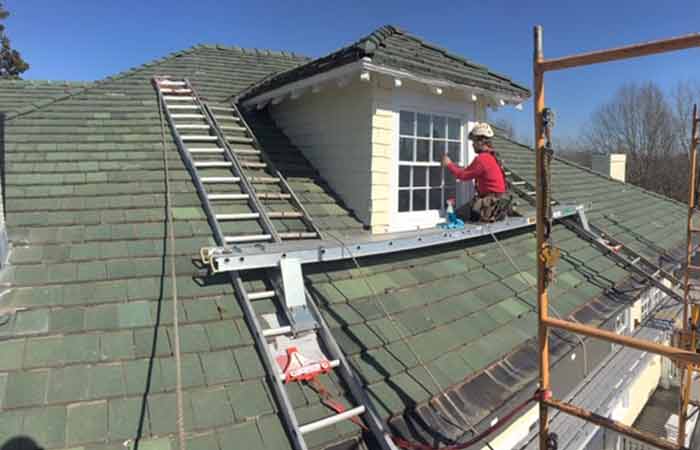
Safety Measures and Tips to Observe with Ladders on Roof
Some safety tips to put in mind when using a ladder either on the roof or on the ground include the following:
- Before going up the ladder, make sure that all the locks on an extension ladder are engaged properly.
- When climbing a ladder, always check to make sure there are no power lines overhead as they pose an electrical hazard.
- No matter how safe it seems, always have a spotter on the ground to check on you as you go up the ladder. This helps prevent issues that you on the ladder might not be able to see.
- You should only use a ladder when it’s on stable ground when it has been secured at the top or bottom. Otherwise, avoid putting ladders on ground that is slippery as the ladder can easily slip away.
- When possible, use a harness to keep you steady on the roof. Make sure the harness is on stable ground and then has been tied firmly but comfortably around your body. This will hold you in place when the ladder falls or slips away.
- You should not place the metal shingles of the ladder on an asphalt roof as it will damage the shingles and is also dangerous for the user. You might slip and fall off in the process. For asphalt roofs, use ladder pads to protect the roof.
- When you put the ladder on the roof, the weight is transferred to the roof’s framework. For this reason, always inspect the frame of the roof and the material used on the roof to ensure they are strong enough to support your weight, that of the ladder and even the tools you will be having.
- If your roof is made of slate tiles, it’s much more slippery hence will be tricky to work on. You should use the Pivit tool and roof boot with care. You can also use a harness to increase the safety of your activities.
- Before you use any ladder, make sure it’s the right height and you can access the work area without standing at the very top of the ladder. Rather, you should have some steps left at the top when working. These are for your hands to hold onto.
- Also, inspect the ladder to make sure it has no loose rungs or broken feet. It should generally be in good condition such that it can bear your weight and won’t let you fall off.
- It’s safe to avoid putting your ladder on the side slope where the back slant is more than 6 degrees or the slope at the side slope is more than 16 degrees. You can only do so with added safety features such as the harness and Pivit tool or roof boot.
- For the safest experience with ladders, use the angle rule of 4:1. For this rule, you should place the ladder 4 meters up for every 1 meter away from the wall. The result is that the ladder should make a 75-degree angle with the roof or wall.
- For added safety, once you climb up the ladder, tie the stiles to a point of your choosing with a rope or strap. This holds the ladder in place such that you stay safely in place in the case that the legs slip and give way.
- Always check the duty rating sticker of your ladder to ensure that you’re safe when loading weights onto it. If it’s an extendable ladder, make sure it has real feet and has spring-loaded rung locks. Don’t be duped into thinking lighter ladders are better as they’re basically of poor quality.
- With or without the ladder, never go onto a roof with dirt and debris. Also, only go onto a roof that’s dry to avoid slipping. Unless absolutely necessary, work from the ladder rather than the roof.
- If you’re using an extension ladder, make sure the locks are properly engaged before you move up the ladder to prevent an accident.
- No matter the angle of the roof, always make sure the rungs of your ladder are on a horizontal plane. That’s why you need ladder leveling tools like the Pivit tool and the roof boot.
- As you climb the ladder, avoid leaning backward or sideways as you might fall off.
- Not all ladders are meant for climbing roofs. You should preferably use ladders meant for roofs for the best safety.
- If you’re afraid of heights, climbing a ladder isn’t the best idea for you. You’d rather have someone else do it for you. You can know you’re afraid of heights when going more than 6 feet off the ground unsettles you.
Being safe is paramount to using ladders. In most cases, you need to follow the tips stated here while making sure the equipment you use is in good condition as well.
More on Ladders and Roofs
- How to Stabilize Roof Ladders on Rooftop & Base
- Best Ladders for Cleaning Gutter & Maintenance
- How to make a Roof Ladder Hook-DIY from Wood & Metal
- How to Clean Gutters from the Ground without a Ladder
As an Amazon Associate, we earn from qualifying purchases. Details here
